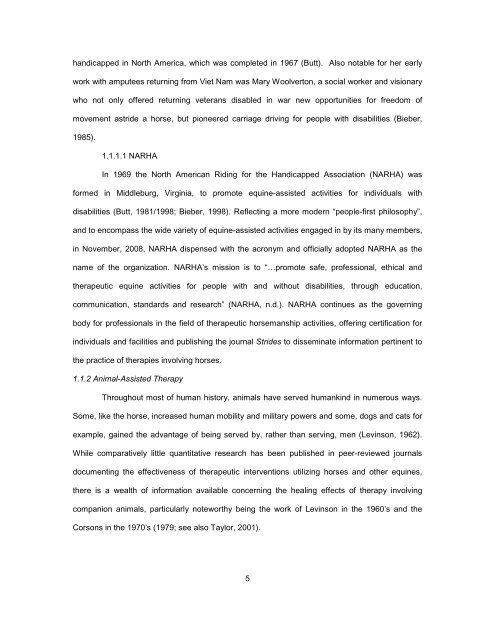A SYSTEMATIC REVIEW OF THE EFFECTS OF PSYCHOTHERAPY ...
A SYSTEMATIC REVIEW OF THE EFFECTS OF PSYCHOTHERAPY ...
A SYSTEMATIC REVIEW OF THE EFFECTS OF PSYCHOTHERAPY ...
You also want an ePaper? Increase the reach of your titles
YUMPU automatically turns print PDFs into web optimized ePapers that Google loves.
handicapped in North America, which was completed in 1967 (Butt). Also notable for her early<br />
work with amputees returning from Viet Nam was Mary Woolverton, a social worker and visionary<br />
who not only offered returning veterans disabled in war new opportunities for freedom of<br />
movement astride a horse, but pioneered carriage driving for people with disabilities (Bieber,<br />
1985).<br />
1.1.1.1 NARHA<br />
In 1969 the North American Riding for the Handicapped Association (NARHA) was<br />
formed in Middleburg, Virginia, to promote equine-assisted activities for individuals with<br />
disabilities (Butt, 1981/1998; Bieber, 1998). Reflecting a more modern “people-first philosophy”,<br />
and to encompass the wide variety of equine-assisted activities engaged in by its many members,<br />
in November, 2008, NARHA dispensed with the acronym and officially adopted NARHA as the<br />
name of the organization. NARHA’s mission is to “…promote safe, professional, ethical and<br />
therapeutic equine activities for people with and without disabilities, through education,<br />
communication, standards and research” (NARHA, n.d.). NARHA continues as the governing<br />
body for professionals in the field of therapeutic horsemanship activities, offering certification for<br />
individuals and facilities and publishing the journal Strides to disseminate information pertinent to<br />
the practice of therapies involving horses.<br />
1.1.2 Animal-Assisted Therapy<br />
Throughout most of human history, animals have served humankind in numerous ways.<br />
Some, like the horse, increased human mobility and military powers and some, dogs and cats for<br />
example, gained the advantage of being served by, rather than serving, men (Levinson, 1962).<br />
While comparatively little quantitative research has been published in peer-reviewed journals<br />
documenting the effectiveness of therapeutic interventions utilizing horses and other equines,<br />
there is a wealth of information available concerning the healing effects of therapy involving<br />
companion animals, particularly noteworthy being the work of Levinson in the 1960’s and the<br />
Corsons in the 1970’s (1979; see also Taylor, 2001).<br />
5
















